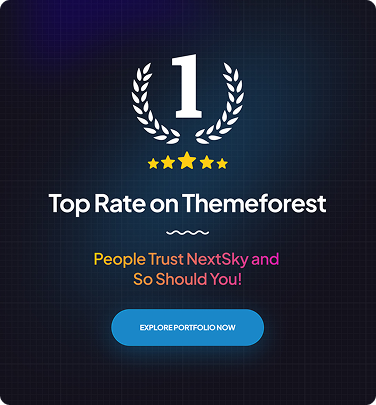Is Shopify Worth It in 2026? A Deep Dive for Entrepreneurs
Table of Contents Hide
In the context of e-commerce booming and becoming a lever for businesses to expand globally, one of the questions that many people are interested in is: "Is Shopify worth it?". In the article below, NextSky will help businesses clearly see the investment value and the suitability of Shopify for long-term business strategy.
Is Shopify worth it in 2026?
Yes, Shopify is still worth it for businesses in 2026. With its robust features, scalability, and market presence, Shopify continues to be one of the best choices for building an online store.
Shopify serves millions of merchants across 175 countries, supporting around 5.5 million online stores. This extensive reach showcases its reliability and stability as a trusted e-commerce platform.
However, whether Shopify is worth it to you depends on your specific business needs, budget, and growth objectives. By carefully evaluating these factors, you can determine if Shopify is the one for you.
Read more: What is Shopify? All Information About The Platform from A-Z
1. Is Shopify’s pricing worth it?
Shopify’s pricing is flexible, with plans tailored to different business sizes. However, add-ons like apps, themes, and transaction fees can impact budgets. Below is a breakdown of Shopify’s 2025 pricing (in USD) and what each plan offers.
Shopify pricing plans
Shopify Starter ($5/month)
- Best for: Selling on social media or existing websites without a full store.
- Features: Payment links, invoicing, basic product management.
- Limitations: No standalone store or advanced features.
Basic Shopify ($39/month, or $29/month annually)
- Best for: New businesses launching full e-commerce stores.
- Features: Custom store, blogging tools, SSL certificate, basic reports, Shopify POS Lite, international selling for up to 3 markets.
- Transaction fees: 2.9% + $0.30 per online transaction (Shopify Payments); 2% for third-party gateways.
Shopify Grow ($105/month, or $79/month annually)
- Best for: Growing businesses needing advanced features.
- Features: All Basic features, lower transaction fees, 5 staff accounts, professional reports, POS Lite.
- Transaction fees: 2.7% + $0.30 per online transaction (Shopify Payments); 1% for third-party gateways.
Advanced Shopify ($399/month, or $299/month annually)
- Best for: High-volume sellers needing custom analytics and shipping.
- Features: All Grow features, 15 staff accounts, advanced report builder, third-party shipping rate calculations.
- Transaction fees: 2.5% + $0.30 per online transaction (Shopify Payments); 0.6% for third-party gateways.
Shopify Plus (starting at $2,300/month)
- Best for: Enterprise-level businesses with complex needs.
- Features: Custom integrations, wholesale channels, advanced APIs, dedicated support.
Hidden costs to consider
- Themes: Shopify offers 13 free themes, but premium ones cost $100–$500 (one-time fee).
- Apps: Essential features (e.g., advanced SEO, upsells) often require paid apps ($5–$100/month).
- Transaction fees: Third-party gateways (e.g., PayPal, Stripe) incur extra fees (0.5%–2% per transaction).
- Domain: $10–$20/year via Shopify or third-party providers.
- Email hosting: Shopify doesn’t offer email hosting, requiring third-party services like Google Workspace.
- Marketing: Budget for ads, email campaigns, or influencer marketing to drive traffic.
To better understand and get a more accurate answer about Shopify, join me for a more in-depth review below:
Read more: Shopify Pricing: Find the Right Plan for Your Business
2. Ease of use
Shopify stands out for its simplicity, making it ideal for those wondering whether to start with the platform. Intuitive drag-and-drop tools, detailed setup guides, and a user-friendly dashboard let you build and launch a store in hours, not days. Here’s why Shopify excels:
- Quick setup: Launch a basic store with a few products in 4–8 hours. Even complex stores take only 1–2 weeks, no coding required.
- Intuitive dashboard: Manage products, orders, and analytics from a single interface.
- Convenient mobile app: Track sales, update inventory, and respond to customers on the go.
- No tech skills needed: Shopify handles hosting, security, and updates, letting you focus on business growth.
Compared to platforms like WooCommerce (requiring WordPress knowledge) or Magento (complex setup), Shopify’s ease of use is unmatched, especially for beginners.
3. Shopify themes
Shopify’s Theme Store offers over 974 themes, including 24 free and 950+ premium ones ($100–$500), ensuring professional, device-optimized stores. Key features include:
- Responsive design: Themes auto-adjust for mobile, tablet, and desktop.
- Sales-driven features: Product filters, 360-degree views, and video backgrounds boost engagement.
- Regular updates: Themes stay compatible with the latest e-commerce standards.
- Customization: Adjust colors, fonts, and layouts via drag-and-drop editors. Advanced users can tweak with Liquid.

4. Shopify integrations
With over 13,000 apps and integrations, Shopify’s ecosystem empowers comprehensive growth:
-
Social media selling
- Facebook: Set up a Facebook Shop to sell products directly.
- Instagram: Tag products in posts and stories for seamless shopping.
- TikTok: Partner with TikTok to create shoppable ads.
- Pinterest: Use Shopify Buy Buttons for direct product sales.
- Shopify marketplace connect: The Marketplace Connect app allows integration with platforms like Amazon, Walmart (U.S. only), eBay, and Etsy. Manage orders, inventory, and listings directly from your Shopify store. Any update on your store is instantly reflected across all linked marketplaces.
-
Multilingual website setup: Shopify supports up to 20 languages (excluding the Starter plan). You can add language-specific folders (e.g.,
myshop.com/fr) or create international domains (e.g.,myshop.fr). Most free themes come with a language selector, but it’s important to verify this for paid themes. - Multi-currency selling: With Shopify Markets, you can manage multiple currencies, regions, and languages. Shopify automatically converts currency based on the visitor's IP address. However, some features, such as duties and taxes, are available only on higher-tier plans. To support countries without Shopify Payments, third-party apps are required.
- Abandoned cart recovery: Shopify offers an abandoned cart recovery feature that sends email reminders with incentives (e.g., discount codes) to users who left their carts. This tool can be customized based on different abandonment triggers and is available on most plans.
5. Shopify reports and analytics
Shopify’s in-depth analytics provide real-time data on sales, traffic, and customer behavior, empowering strategic decisions.
- Dashboard overview: Get a quick snapshot of sales, orders, and traffic in seconds.
- Sales reports: Analyze revenue trends, product performance, and transaction history, with customizable reports for specific goals.
-
Key reports:
- Marketing reports: Identify top traffic sources, campaign performance, and channel conversions.
- Sales reports: Spot best-sellers, daily/weekly/seasonal trends.
- Behavior reports: Track customer interactions, top pages, session duration, and exit points.
- Order reports: Monitor order volume, status, and repeat purchase habits.
- Additional Reports: Online Store Cart Analysis, Profit Reports, Profit by Point of Sale Location, Finance, Returning Customers, Top Online Store Searches, Retail Sales by Product, Store Conversion Over Time, Acquisition Reports, Inventory Reports, Online Store Speed, Refund Rate.

6. Shopify security
Shopify is built with top-tier security, ensuring safe transactions and customer data for worry-free online business. Key features include:
- SSL certificates: Encrypt all data, protecting payment and customer info.
- PCI DSS compliance: Meets global standards for secure card payments.
- Fraud detection: Smart systems flag and alert suspicious activities.
- Cookie policies: Tools to create and manage data-compliant cookie policies.

Note: While Shopify provides a secure default environment, third-party apps require caution. Choose reputable developers and regularly review access permissions to maximize protection.
7. Shopify SEO and marketing
To thrive in e-commerce, proactive SEO and marketing are essential. While Shopify is a strong launchpad, it falls short for advanced users’ needs.
SEO features
- Built-in tools: Edit meta titles, descriptions, alt text; create custom URLs and 301 redirects.
- Mobile optimization: All themes are mobile-friendly, a key Google ranking factor.
- Speed: Shopify’s CDN ensures fast load times, reducing bounce rates.
- Apps: Tools like SEO Manager and Avada SEO Suite enhance technical optimization.
However, here are some limitations.
- Forced URL structures (e.g., “/products/”) can complicate SEO.
- Limited control over robots.txt and sitemaps without apps.
- Advanced SEO requires third-party tools, increasing costs.
Marketing tools
- Shopify Email: Send up to 10,000 free emails/month with customizable templates.
- Blogging: Basic blogging for content marketing, but lacks advanced features like categories or analytics.
- Abandoned cart recovery: Built into all plans to re-engage customers.
- Social ads: Run campaigns on Facebook, Instagram, and TikTok from Shopify’s dashboard.

8. Shopify for dropshipping
Shopify is the top platform for dropshipping due to its standout advantages:
- Low-cost startup: No need for warehouses or heavy infrastructure. Apps like DSers automate order receipt, dispatch, and tracking, saving time and costs.
- Flexible product testing: Quickly add, remove, or swap products to test items like fashion, accessories, or tech without high risks.
- Scalable infrastructure: Handle thousands of orders simultaneously without slowdowns or technical issues.
- Optimized marketing and SEO: Robust apps, SEO tools, and user-friendly themes help attract customers and boost sales.
9. Shopify support
Shopify offers 24/7 support via chat and email, but only phone support remains for Shopify Plus users. Live chat starts with an AI assistant and is limited to languages, while emails require filling out a form and waiting 24 hours for a response. Users have reported that the loss of phone support and slow chat are frustrating. Online documentation is clear but mostly text-based, lacking images and videos. Overall, the changes have led to a decline in customer service.
Pros and cons of Shopify
Shopify is widely known for its user-friendly interface and robust features, making it a popular option. Yet, every platform has its advantages and drawbacks.
Pros
- Beginner-friendly: Shopify’s drag-and-drop tools and step-by-step guides let you launch a store in hours, even without technical skills.
- Scalability: From small startups to large enterprises, Shopify’s infrastructure supports growth, handling high traffic and large product catalogs seamlessly.
- Massive app ecosystem: With over 13,000 apps, Shopify enables features like SEO tools, marketing automation, and dropshipping integrations.
- Multi-channel selling: Sell effortlessly on websites, social media, platforms like Amazon, and in-person with Shopify POS.
- Reliable performance: Shopify’s global content delivery network (CDN) ensures fast load times, while built-in security features like SSL certificates and PCI compliance protect your store.
Cons
- Additional costs: Monthly subscriptions, transaction fees, and premium apps/themes can inflate budgets.
- Customization limits: Advanced design changes require knowledge of Shopify’s Liquid language or third-party apps.
- Platform lock-in: Migrating away from Shopify can be complex due to its proprietary system.
Is Shopify right for you?
Shopify is worth it if you:
- Want an easy-to-use platform to launch quickly.
- Need scalability without technical hassles.
- Plan to sell across multiple channels (web, social, marketplaces).
- Value reliable performance and security.
It’s less ideal if:
- You’re on a very limited budget (consider marketplaces like Etsy first).
- You need advanced content management (WordPress is better).
- Your business exceeds $5 million/month in revenue (Shopify Plus or Magento might be a better fit).
Is Shopify worth it in 2026? Shopify remains a leading e-commerce platform, offering ease of use, scalability, and superior integrations for businesses of all sizes. Its ability to simplify store setup, support multi-channel selling, and ensure reliable performance make it a strong choice for growing entrepreneurs and brands.










